AMAZON multi-meters discounts AMAZON oscilloscope discounts
1. Definitions and Standards: The National Electric Code • From the IEEE Dictionary—Std. 100 • Green Book (IEEE Std. 142) Definitions • NEC Definitions
2. Reasons for Grounding: Personal Safety • Protective Device Operation • Noise Control
3. Typical Wiring and Grounding Problems: Insulated Grounds • Ground Loops • Missing Safety Ground • Multiple Neutral to Ground Bonds • Additional Ground Rods • Insufficient Neutral Conductor • Summary
4. Case Study: Case Study: Flickering Lights
Perhaps one of the most common problems related to power quality is wiring and grounding. It has been reported that approximately 70%-80% of all power quality related problems can be attributed to faulty connections and/or wiring. This section describes wiring and grounding issues as they relate to power quality. It’s not intended to replace or supercede the National Electric Code (NEC) or any local codes concerning grounding.
1. Definitions and Standards
Defining grounding terminology is outside the scope of this section. There are several publications on the topic of grounding that define grounding terminology in various levels of detail. The reader is referred to these publications for the definitions of grounding terminology.
The following is a list of standards and recommended practice pertaining to wiring and grounding issues. See the section on References for complete information.
National Electric Code Handbook:
IEEE Std. 1100-1999. IEEE Recommended Practice for Powering and Grounding Electronic Equipment.
IEEE Std. 142-1991. IEEE Recommended Practice for Grounding Industrial and Commercial Power Systems.
Guideline on Electrical Power for ADP Installations, Federal Information Processing Standards (FIPS) Publication 94, September 1983.
Electrical Power Systems Quality
1.1 The National Electric Code
NFPAs National Electrical Code Hand book pulls together all the extra facts, figures, and explanations readers need to interpret the 1999 NEC. It includes the entire text of the Code, plus expert commentary, real-world examples, diagrams, and illustrations that clarify requirements. Code text appears in blue type and commentary stands out in black. It also includes a user-friendly index that references article numbers to be consistent with the Code.
Several definitions of grounding terms pertinent to discussions in this article have been included for reader convenience. The following definitions were taken from various publications as cited.
1.2 From the IEEE Dictionary-Std. 100
Grounding: A conducting connection, whether intentional or accidental, by which an electric circuit or equipment is connected to the earth, or to some conducting body of relatively large extent that serves in place of the earth. It’s used for establishing and maintaining the potential of the earth (or of the conducting body) or approximately that potential, on conductors connected to it; and for conducting ground current to and from the earth (or the conducting body).
1.3 Green Book (IEEE Std. 142) Definitions
Ungrounded system: A system, circuit, or apparatus without an intentional connection to ground, except through potential indicating or measuring devices or other very high impedance devices.
Grounded system: A system of conductors in which at least one conductor or point (usually the middle wire or neutral point of transformer or generator windings) is intentionally grounded, either solidly or through an impedance.
====
Grounding electrode conductor NEC 250-26(b); Grounding electrode NEC 250-26(c); Earth or other conducting material; Equipment grounding conductors; Load Metallic conductor enclosure NEC 250-91(b); Supply Bond NEC 250-26(e) -- System overcurrent protection Grounded conductor
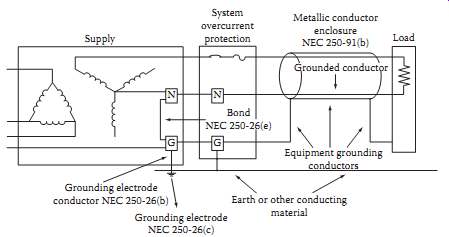
FGR. 1 Terminology used in NEC definitions.
====
1.4 NEC Definitions
Refer to FGR. 1.
Bonding jumper, main: The connector between the grounded circuit conductor (neutral) and the equipment-grounding conductor at the service entrance.
Conduit/Enclosure bond: (bonding definition) The permanent joining of metallic parts to form an electrically conductive path which will assure electrical continuity and the capacity to conduct safely any current likely to be imposed.
Grounded: Connected to earth or to some conducting body that serves in place of the earth.
Grounded conductor: A system or circuit conductor that is intentionally grounded (the grounded conductor is normally referred to as the neutral conductor).
Grounding conductor: A conductor used to connect equipment or the grounded circuit of a wiring sys tem to a grounding electrode or electrodes.
Grounding conductor, equipment: The conductor used to connect the noncurrent-carrying metal parts of equipment, raceways, and other enclosures to the system grounded conductor and/or the grounding electrode conductor at the service equipment or at the source of a separately derived system.
Grounding electrode conductor: The conductor used to connect the grounding electrode to the equipment grounding conductor and/or to the grounded conductor of the circuit at the service equipment or at the source of a separately derived system.
Grounding electrode: The grounding electrode shall be as near as practicable to and preferably in the same area as the grounding conductor connection to the system. The grounding electrode shall be: (1) the nearest available effectively grounded structural metal member of the structure; or (2) the nearest available effectively grounded metal water pipe; or (3) other electrodes (Sections 250-81 and 250-83) where electrodes specified in (1) and (2) are not available.
Grounding electrode system: Defined in NEC Section 250-81 as including: (a) metal underground water pipe; (b) metal frame of the building; (c) concrete-encased electrode; and (d) ground ring. When these elements are available, they are required to be bonded together to form the grounding electrode system.
Where a metal underground water pipe is the only grounding electrode available, it must be supplemented by one of the grounding electrodes specified in Section 250-81 or 250-83.
Separately derived systems: A premises wiring system whose power is derived from generator, transformer, or converter windings and has no direct electrical connection, including a solidly connected grounded circuit conductor, to supply conductors originating in another system.
2. Reasons for Grounding
There are three basic reasons for grounding a power system: personal safety, protective device operation, and noise control. All three of these reasons will be addressed.
===
Missing safety ground
"Hot" leg shorted to frame Touch potential Not a ground
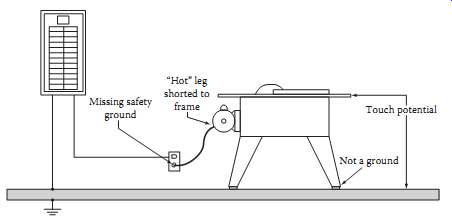
FGR. 2 Illustration of a dangerous touch potential situation.
===
2.1 Personal Safety
The most important reason for grounding a device on a power system is personal safety. The safety ground, as it’s sometimes called, is provided to reduce or eliminate the chance of a high touch potential if a fault occurs in a piece of electrical equipment. Touch potential is defined as the voltage potential between any two conducting materials that can be touched simultaneously by an individual or animal.
FGR. 2 illustrates a dangerous touch potential situation. The "hot" conductor in the piece of equipment has come in contact with the case of the equipment. Under normal conditions, with the safety ground intact, the protective device would operate when this condition occurred. However, in FGR. 2, the safety ground is missing. This allows the case of the equipment to float above ground since the case of the equipment is not grounded through its base. In other words, the voltage potential between the equipment case and ground is the same as the voltage potential between the hot leg and ground. If the operator would come in contact with the case and ground (the floor), serious injury could result.
In recent years, manufacturers of handheld equipment, drills, saws, hair dryers, etc., have developed double insulated equipment. This equipment generally does not have a safety ground. However, there is never any conducting material for the operator to contact and therefore there is no touch potential hazard. If the equipment becomes faulted, the case or housing of the equipment is not energized.
2.2 Protective Device Operation
As mentioned in the previous section, there must be a path for fault current to return to the source if protective devices are to operate during fault conditions. The NEC requires that an effective grounding path must be mechanically and electrically continuous (NEC 250-51), have the capacity to carry any fault currents imposed on it without damage (NEC 250-75). The NEC also states that the ground path must have sufficiently low impedance to limit the voltage and facilitate protective device operation.
Finally, the earth cannot serve as the equipment-grounding path (NEC-250-91(c)).
The formula to determine the maximum circuit impedance for the grounding path is
Ground Path Impedance = Maximum Voltage to Ground / Over-current Protection Rating × 5
Table 1 gives examples of maximum ground path circuit impedances required for proper protective device operation.
2.3 Noise Control
Noise control is the third main reason for grounding. Noise is defined as unwanted voltages and cur rents on a grounding system. This includes signals from all sources whether it’s radiated or conducted.
As stated, the primary reason for grounding is safety and is regulated by the NEC and local codes. Any changes to the grounding system to improve performance or eliminate noise control must be in addition to the minimum NEC requirements.

TABLE 1 Example Ground Impedance Values

FGR. 3 Separation of loads for noise control.
When potential differences occur between different grounding systems, insulation can be stressed and circulating currents can be created in low voltage cables (e.g., communications cables). In today's electrical environment, buildings that are separated by large physical distances are typically tied together via a communication circuit. An example of this would be a college campus that may cover several square miles. Each building has its own grounding system. If these grounding systems are not tied together, a potential difference on the grounding circuit for the communication cable can occur. The idea behind grounding for noise control is to create an equipotential grounding system, which in turn limits or even eliminates the potential differences between the grounding systems. If the there is an equipotential grounding system and currents are injected into the ground system, the potential of the whole grounding system will rise and fall and potential differences won’t occur.
Supplemental conductors, ground reference grids, and ground plates can all be used to improve the performance of the system as it relates to power quality. Optically isolated communications can also improve the performance of the system. By using the opto-isolators, connecting the communications to different ground planes is avoided. All improvements to the grounding system must be done in addition to the requirements for safety.
Separation of loads is another method used to control noise. FGR. 3 illustrates this point. FGR. 3 shows four different connection schemes. Each system from left to right improves noise control.
As seen in FGR. 3, the best case would be the complete separation (system on the far right) of the ADP units from the motor loads and other equipment. Conversely, the worst condition is on the left of FGR. 3 where the ADP units are served from the same circuit as the motor loads.
3. Typical Wiring and Grounding Problems
In this section, typical wiring and grounding problems, as related to power quality, are presented.
Possible solutions are given for these problems as well as the possible causes for the problems being observed on the grounding system. The following list is just a sample of problems that can occur on the grounding system.
• Isolated grounds
• Ground loops
• Missing safety ground
• Multiple neutral-to-ground bonds
• Additional ground rods
• Insufficient neutral conductors
===
TABLE 2: Typical Wiring and Grounding Problems and Causes Wiring Condition or Problem
Observed ---- Possible Cause
Observed:
[Impulse, voltage drop out Impulse, voltage drop out Ground currents Ground currents Extreme voltage fluctuations Voltage fluctuations High neutral to ground voltage Burnt smell at the panel, junction box, or load Panel or junction box is warm to the touch Buzzing sound Scorched insulation Scorched panel or junction box No voltage at load equipment Intermittent voltage at the load equipment]
Possible Cause:
[Loose connections Faulty breaker Extra neutral-to-ground bond Neutral-to-ground reversal High impedance in neutral circuit High impedance neutral-to-ground bonds High impedance ground Faulted conductor, bad connection, arcing, or overloaded wiring Faulty circuit breaker or bad connection Arcing Overloaded wiring, faulted conductor, or bad connection Bad connection, faulted conductor Tripped breaker, bad connection, or faulted conductor Bad connection or arcing]
===
Equipment ground (bare wire)
Insulated ground terminal
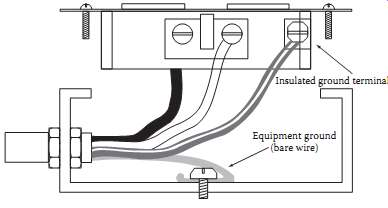
FGR. 4 Properly wired isolated ground circuit.
===
3.1 Insulated Grounds
Insulated grounds in themselves are not a grounding problem. However, improperly used insulated grounds can be a problem. Insulated grounds are used to control noise on the grounding system. This is accomplished by using insulated ground receptacles, which are indicated by a "?" on the face of the outlet. Insulated ground receptacles are often orange in color. FGR. 4 illustrates a properly wired insulated ground circuit.
The 1996 NEC has this to say about insulated grounds.
NEC 250-74. Connecting Receptacle Grounding Terminal to Box. An equipment bonding jumper shall be used to connect the grounding terminal of a grounding-type receptacle to a grounded box.
Exception No. 4. Where required for the reduction of electrical noise (electromagnetic interference) on the grounding circuit, a receptacle in which the grounding terminal is purposely insulated from the receptacle mounting means shall be permitted. The receptacle grounding terminal shall be grounded by an insulated equipment grounding conductor run with the circuit conductors. This grounding conductor shall be permitted to pass through one or more panelboards without connection to the panelboard grounding terminal as permitted in Section 384-20, Exception so as to terminate within the same building or structure directly at an equipment grounding conductor terminal of the applicable derived system or source.
(FPN): Use of an isolated equipment grounding conductor does not relieve the requirement for grounding the raceway system and outlet box.
NEC 517-16. Receptacles with Insulated Grounding Terminals. Receptacles with insulated grounding terminals, as permitted in Section 250-74, Exception No. 4, shall be identified; such identification shall be visible after installation.
(FPN): Caution is important in specifying such a system with receptacles having insulated grounding terminals, since the grounding impedance is controlled only by the grounding conductors and does not benefit functionally from any parallel grounding paths.
The following is a list of pitfalls that should be avoided when installing insulated ground circuits.
• Running an insulated ground circuit to a regular receptacle.
• Sharing the conduit of an insulated ground circuit with another circuit.
• Installing an insulated ground receptacle in a two-gang box with another circuit.
• Not running the insulated ground circuit in a metal cable armor or conduit.
• Don’t assume that an insulated ground receptacle has a truly insulated ground.
===
Communications cable

FGR. 5 Circuit with a ground loop.
Communications cable FGR. 6 Grounding electrodes must be bonded together.
===
3.2 Ground Loops
Ground loops can occur for several reasons. One is when two or more pieces of equipment share a common circuit like a communication circuit, but have separate grounding systems (FGR. 5).
To avoid this problem, only one ground should be used for grounding systems in a building. More than one grounding electrode can be used, but they must be tied together (NEC 250-81, 250-83, and 250-84) as illustrated in FGR. 6.
3.3 Missing Safety Ground
As discussed previously, a missing safety ground poses a serious problem. Missing safety grounds usually occur because the safety ground has been bypassed. This is typical in buildings where the 120-V outlets only have two conductors. Modern equipment is typically equipped with a plug that has three prongs, one of which is a ground prong. When using this equipment on a two-prong outlet, a grounding plug adapter or "cheater plug" can be employed provided there is an equipment ground present in the outlet box. This device allows the use of a three-prong device in a two-prong outlet. When properly connected, the safety ground remains intact. FGR. 7 illustrates the proper use of the cheater plug.
If an equipment ground is not present in the outlet box, then the grounding plug adapter should not be used. If the equipment grounding conductor is present, the preferred method for solving the missing safety ground problem is to install a new three-prong outlet in the outlet box. This method insures that the grounding conductor won’t be bypassed. The NEC discusses equipment grounding conductors in detail in Section 250-Grounding.
===
Screw must be connected to outlet cover and outlet yoke

FGR. 7 Proper use of a grounding plug adapter or "cheater plug."
Panel board Panel board Data cable
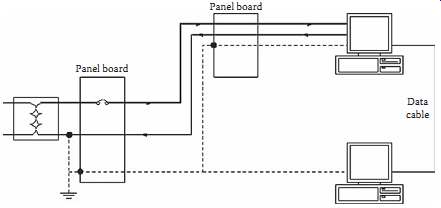
FGR. 8 Neutral current flow with one neutral-to-ground bond.
===
Data cable Panel board Panel board Extra bond FGR. 9 Neutral current flow with and extra neutral-to-ground bond.
Supply -- System overcurrent protection Panel board Separately derived system Receptacle Load Bond NEC 250-26(e) Bond NEC 250-26(e) Phase conductor Ground conductor Ground conductor Grounding electrode NEC 250-26(c) Grounding electrode conductor NEC 250-26(b)
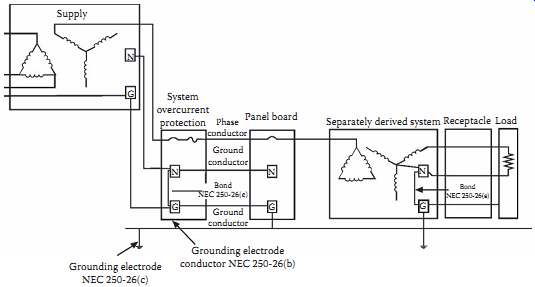
FGR. 10 Example of the use of a separately derived system.
===
3.4 Multiple Neutral to Ground Bonds
Another misconception when grounding equipment is that the neutral must be tied to the grounding conductor. Only one neutral-to-ground bond is permitted in a system or sub-system. This typically occurs at the service entrance to a facility unless there is a separately derived system. A separately derived system is defined as a system that receives its power from the windings of a transformer, generator, or some type of converter. Separately derived systems must be grounded in accordance with NEC 250-26.
The neutral should be kept separate from the grounding conductor in all panels and junction boxes that are downline from the service entrance. Extra neutral-to-ground bonds in a power system will cause neutral currents to flow on the ground system. This flow of current on the ground system occurs because of the parallel paths. FGR. 8 and 9 illustrate this effect.
As seen in FGR. 9, neutral current can find its way onto the ground system due to the extra neutral-to-ground bond in the secondary panel board. Notice that not only will current flow in the ground wire for the power system, but currents can flow in the shield wire for the communication cable between the two PCs.
If the neutral-to-ground bond needs to be reestablished (high neutral-to-ground voltages), this can be accomplished by creating a separately derived system as defined above. FGR. 10 illustrates a separately derived system.
3.5 Additional Ground Rods
Additional ground rods are another common problem in grounding systems. Ground rods for a facility or building should be part of the grounding system. The ground rods should be connected where all the building grounding electrodes are bonded together. Isolated grounds can be used as described in the NEC's Isolated Ground section, but should not be confused with isolated ground rods, which are not permitted.
The main problem with additional ground rods is that they create secondary paths for transient currents, such as lightning strikes, to flow. When a facility incorporates the use of one ground rod, any currents caused by lightning will enter the building ground system at one point. The ground potential of the entire facility will rise and fall together. However, if there is more than one ground rod for the facility, the transient current enters the facility's grounding system at more than one location and a portion of the transient cur rent will flow on the grounding system causing the ground potential of equipment to rise at different levels.
This, in turn, can cause severe transient voltage problems and possible conductor overload conditions.
====
Neutral current contains no fundamental, but third harmonic is 300% of phase current Balanced fundamental currents sum to 0, but balanced third harmonic currents coincide
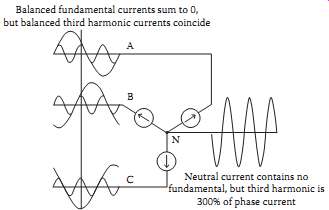
FGR. 11 A balanced three-phase system.
Load DC to DC regulator
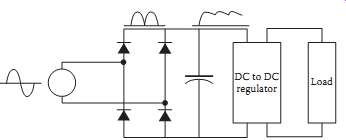
FGR. 12 The basic one-line for a SMPS.
====
Neutral current contains no fundamental, but third harmonic is 300% of phase current Balanced fundamental currents sum to 0, but balanced third harmonic currents coincide

FGR. 13 Balanced single-phase loads.
===
3.6 Insufficient Neutral Conductor
With the increased use of electronic equipment in commercial buildings, there is a growing concern for the increased current imposed on the grounded conductor (neutral conductor). With a typical three-phase load that is balanced, there is theoretically no current flowing in the neutral conductor, as illustrated in FGR. 11.
However, PCs, laser printers, and other pieces of electronic office equipment all use the same basic technology for receiving the power that they need to operate. FGR. 12 illustrates the typical power supply of a PC. The input power is generally 120 V AC, single phase. The internal electronic parts require various levels of DC voltage (e.g., ±5, 12 V DC) to operate. This DC voltage is obtained by converting the AC volt age through some type of rectifier circuit as shown. The capacitor is used for filtering and smoothing the rectified AC signal. These types of power supplies are referred to as switch mode power supplies (SMPS).
The concern with devices that incorporate the use of SMPS is that they introduce triplen harmonics into the power system. Triplen harmonics are those that are odd multiples of the fundamental frequency component (h = 3, 9, 15, 21,…). For a system that has balanced single-phase loads as illustrated in FGR. 13, fundamental and third harmonic components are present. Applying Kirchoff's current law at node N shows that the fundamental current component in the neutral must be zero. But when loads are balanced, the third harmonic components in each phase coincide. Therefore, the magnitude of third harmonic current in the neutral must be three times the third harmonic phase current.
This becomes a problem in office buildings when multiple single-phase loads are supplied from a three-phase system. Separate neutral wires are run with each circuit, therefore the neutral current will be equivalent to the line current. However, when the multiple neutral currents are returned to the panel or transformer serving the loads, the triplen currents will add in the common neutral for the panel and this can cause overheating and eventually even cause failure of the neutral conductor. If office partitions are used, the same, often undersized neutral conductor is run in the partition with three-phase conductors. Each receptacle is fed from a separate phase in order to balance the load current. However, a single neutral is usually shared by all three phases. This can lead to disastrous results if the partition electrical receptacles are used to supply nonlinear loads rich in triplen harmonics.
Under the worst conditions, the neutral current will never exceed 173% of the phase current.
FGR. 13 illustrates a case where a three-phase panel is used to serve multiple single-phase SMPS PCs.
===
TABLE 3
Summary of Wiring and Grounding Issues
Summary Issues
Good power quality and noise control practices don’t conflict with safety requirements.
Wiring and grounding problems cause a majority of equipment interference problems.
Make an effort to put sensitive equipment on dedicated circuits.
The grounded conductor, neutral conductor, should be bonded to the ground at the transformer or main panel, but not at other panel down line except as allowed by separately derived systems.
===
3.7 Summary:
As discussed previously, the three main reasons for grounding in electrical systems are
1. Personal safety
2. Proper protective device operation
3. Noise control By following the guidelines found below, the objectives for grounding can be accomplished.
• All equipment should have a safety ground. A safety ground conductor.
• Avoid load currents on the grounding system.
• Place all equipment in a system on the same equipotential reference.
4. Case Study
This section presents a case study involving wiring and grounding issues. The purpose of this case study is to inform the reader on the procedures used to evaluate wiring and grounding problems and present solutions.
4.1 Case Study: Flickering Lights
This case study concerns a residential electrical system. The homeowners were experiencing light flicker when loads were energized and deenergized in their homes.
4.1.1 Background
Residential systems are served from single-phase transformers employing a spilt secondary winding, often referred to as a single-phase three-wire system. This type of transformer is used to deliver both 120- and 240-V single-phase power to the residential loads. The primary of the transformer is often served from a 12 to 15 kV distribution system by the local utility. FGR. 14 illustrates the concept of a split-phase system.
When this type of service is operating properly, 120 V can be measured from either leg to the neutral conductor. Due to the polarity of the secondary windings in the transformer, the polarity of each 120 V leg is opposite the other, thus allowing a total of 240 V between the legs as illustrated. The proper operation of this type of system is dependent on the physical connection of the neutral conductor or center tap of the secondary winding. If the neutral connection is removed, 240 V will remain across the two legs, but the line to-neutral voltage for either phase can be shifted, causing either a low or high voltage from line to neutral.
Most loads in a residential dwelling, i.e., lighting, televisions, microwaves, home electronics, etc., are operated from 120 V. However, there are a few major loads that incorporate the use of the 240 V avail able. These loads include electric water heaters, electric stoves and ovens, heat pumps, etc.
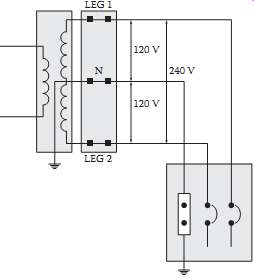
FGR. 14 Split-phase system serving a residential customer.
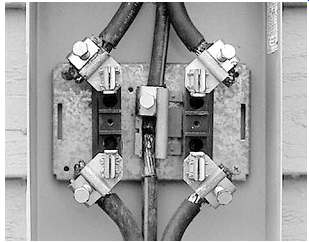
FGR. 15 Actual residential meter base. Notice the missing neutral clamp on
load side of meter.
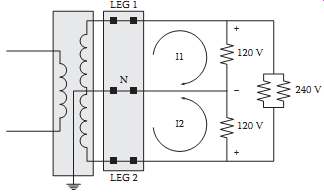
FGR. 16 The effects of a solid neutral connection in the meter base.
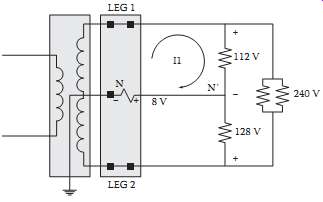
FGR. 17 The effects of a loose neutral connection in the meter base.
4.1.2 The Problem
In this case, there were problems in the residence that caused the homeowner to question the integrity of the power system serving his home. On occasion, the lights would flicker erratically when the washing machine and dryer were operating at the same time. When large single-phase loads were operated, low power incandescent light bulb intensity would flicker.
Measurements were performed at several 120-V outlets throughout the house. When the microwave was operated, the voltage at several of the 120-V outlets would increase from 120 V nominal to 128 V. The voltage would return to normal after the microwave was turned off. The voltage would also increase when a 1500 W space heater was operated. It was determined that the voltage would decrease to approximately 112 V on the leg from which the large load was served. After the measurements confirmed suspicions of high and low voltages during heavy load operation, finding the source of the problem was the next task at hand.
The hunt began at the service entrance to the house. A visual inspection was made of the meter base and socket after the meter was removed by the local utility. It was discovered that one of the neutral connectors was loose. While attempting to tighten this connector, the connector fell off of the meter socket into the bottom of the meter base (see FGR. 15). Could this loose connector have been the cause of the flickering voltage? Let's examine the effects of the loose neutral connection.
FGR. 16 and 17 will be referred to several times during this discussion. Under normal conditions with a solid neutral connection (FGR. 16), load current flows through each leg and is returned to the source through the neutral conductor. There is very little impedance in either the hot or the neutral conductor; therefore, no appreciable voltage drop exists.
When the neutral is loose or missing, a significant voltage can develop across the neutral connection in the meter base, as illustrated in FGR. 17. When a large load is connected across Leg 1 to N and the other leg is lightly loaded (i.e., Leg 1 to N is approximately 10 times the load on Leg 2 to N), the current flowing through the neutral will develop a voltage across the loose connection. This voltage is in phase with the voltage from Leg 1 to N' (see FGR. 17) and the total voltage from Leg 1 to N will be 120 V. However, the voltage sup plied to any loads connected from Leg 2 to N' will rise to 128 V, as illustrated in FGR. 17. The total voltage across the Leg 1 and Leg 2 must remain constant at 240 V. It should be noted that the voltage from Leg 2 to N will be 120 V since the voltage across the loose connection is 180° out of phase with the Leg 2 to N' voltage.
Therefore, with the missing neutral connection, the voltage from Leg 2 to N' would rise, causing the light flicker. This explains the rise in voltage when a large load was energized on the system.
4.1.3 The Solution
The solution in this case was simple-replace the failed connector.
4.1.4 Conclusions
Over time, the neutral connector had become loose. This loose connection caused heating, which in turn caused the threads on the connector to become worn, and the connector failed. After replacing the connector in the meter base, the flickering light phenomena disappeared.
On systems of this type, if a voltage rise occurs when loads are energized, it’s a good indication that the neutral connection may be loose or missing.